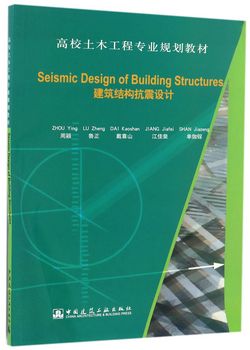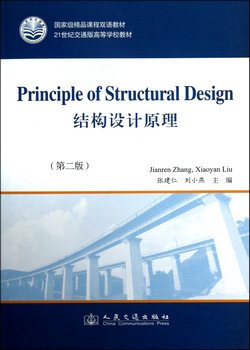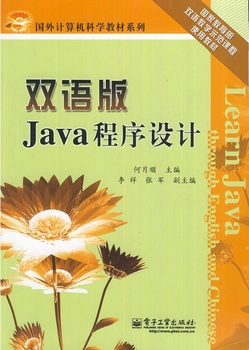- 中南大学出版社
- 9787548711933
- 184833
- 0050164404-1
- TU
- 土木工程
- 本科
内容简介
宇德明主编的《土木工程专业英语(普通高校土木工程专业系列精品规划教材)》包括16章,各章内容既相互联系、又相对独立。每章包括阅读课文、生词和短语、难句分析和练习题。本书选材遵循下列基本原则:相关性、权威性、新颖性和广泛性。相关性原则要求教材内容与土木工程、工程管理、项目管理密切相关,权威性原则要求教材内容选自国外权威学者、机构的英文原著,新颖性原则要求教材内容尽可能选自国外学者、机构最近5年发表的著作,广泛性原则要求教材内容涉及基础工程、道路工程、铁道工程、隧道工程、桥梁工程、房建工程及其项目管理。
本书可作为高等院校土木工程、工程管理、项目管理专业本科生、研究生的专业英语教材。对于有志提高自身科技英语阅读、翻译和写作水平的理工科其他专业师生、工程技术人员和工程管理人员,本书亦有重要参考价值。
本书可作为高等院校土木工程、工程管理、项目管理专业本科生、研究生的专业英语教材。对于有志提高自身科技英语阅读、翻译和写作水平的理工科其他专业师生、工程技术人员和工程管理人员,本书亦有重要参考价值。
目录
Chapter 1 Spread footings and driven pile foundations
1.1 Spread footings
1.2 Driven piles
1.3 Factors to be considered in selecting piles
Chapter 2 Flexible pavements
2.1 Conventional flexible pavements
2.2 Full-depth asphalt pavements
2.3 Contained rock asphalt mats
Chapter 3 The railway cross section
3.1 Ballast
3.2 Crossties or sleepers
3.3 Rails
3.4 Tie plates
3.5 Fastenings
3.6 Rail anchors
3.7 Rail joints
Chapter 4 New Austrian tunneling method
4.1 Introduction
4.2 Historical aspects of NATM
4.3 General concepts of NATM
4.4 Scope of application of NATM
4.5 Concluding remarks
Chapter 5 The Analysis of Controlled Deformations (ADECO) and its advantages
5.1 ADECO approach
5.2 Advantages of the ADECO approach over sequential excavation and NATM
5.3 Conclusions
Chapter 6 Productive modeling for development of as-built BIM of existing indoor structures
6.1 Introduction
6.2 Conventional methods
6.3 Proposed approach
6.4 Experiments and results
6.5 Conclusions
Chapter 7 Technology development in construction: a continuum from distant past into the future
7.1 Introduction
7.2 Creativity and technology
7.3 Historical retrospective
7.4 Linking the present to the past
7.5 Innovation environment in construction technology and possible way forward
Chapter 8 Life cycle design and prefabrication in buildings: A review and case studies in Hong Kong
8.1 Introduction
8.2 Research methodology
8.3 Results and discussion
8.4 Conclusions
Chapter 9 Construction assessment and long-term prediction of prestressed concrete bridges based on monitoring data
9.1 Introduction
9.2 Case study
9.3 Finite element analysis
9.4 Results and discussion
9.5 Conclusions
Chapter 10 Revised case-based reasoning model development based on multiple regression analysis for railroad bridge construction
10.1 Introduction
10.2 Current status of cost estimation for railroad-bridge construction in South Korea
10.3 Case-based reasoning and genetic algorithm methodology
10.4 Estimation of approximate construction cost using case-based reasoning
10.5 Conclusion
Chapter 11 Preparation of tender documents
11.1 General
11.2 Letter of invitation to tender
11.3 Instruetions to tenderers
11.4 Conditions of contract
11.5 Specifications
11.6 Drawings
11.7 Bill of quantities/schedule of prices
11.8 List of additional information required from the tenderers
Chapter 12 Evaluation of tenders and award of contract
12.1 Review of tenders
12.2 Tenders containing deviations
12.3 Adjudication of tenders
12.4 Rejection of all tenders
12.5 Award of contract
Chapter 13 Study of the relationship between procurement duration and project performance in Design-Build projects: comparison between water/wastewater and transportation sectors
13.1 Introduction
13.2 Background
13.3 Research methodology
13.4 Results
13.5 Discussion of findings
13.6 Conclusions
Chapter 14 Design management in Design-Build megaprojects: SR 99 Bored Tunnel case study
14.1 Introduction
14.2 Research methodology
14.3 Background
14.4 Project design management
14.5 Lesson learned to date and conclusions
Chapter 15 Cost management on PFI projects
15.1 Introduction
15.2 Structure of BOT projects
15.3 Case study: Nottingham Express Transit (NET) Light Rail
15.4 Factors leading to success on BOT projects
15.5 Risks and securities
15.6 Case study : Sydney SuperDome, Australia
15.7 The Private Finance Initiative (PFI)
15.8 The role of the cost consultant in PFI/PPP projects
15.9 Case study: Stoke-on-Trent Schools, UK
15.10 Conclusion
Chapter 16 Assessment of expressway construction using Quality Performance Index
16.1 Introduction
16.2 Quality assessment items
16.3 Diagnosis of qu
1.1 Spread footings
1.2 Driven piles
1.3 Factors to be considered in selecting piles
Chapter 2 Flexible pavements
2.1 Conventional flexible pavements
2.2 Full-depth asphalt pavements
2.3 Contained rock asphalt mats
Chapter 3 The railway cross section
3.1 Ballast
3.2 Crossties or sleepers
3.3 Rails
3.4 Tie plates
3.5 Fastenings
3.6 Rail anchors
3.7 Rail joints
Chapter 4 New Austrian tunneling method
4.1 Introduction
4.2 Historical aspects of NATM
4.3 General concepts of NATM
4.4 Scope of application of NATM
4.5 Concluding remarks
Chapter 5 The Analysis of Controlled Deformations (ADECO) and its advantages
5.1 ADECO approach
5.2 Advantages of the ADECO approach over sequential excavation and NATM
5.3 Conclusions
Chapter 6 Productive modeling for development of as-built BIM of existing indoor structures
6.1 Introduction
6.2 Conventional methods
6.3 Proposed approach
6.4 Experiments and results
6.5 Conclusions
Chapter 7 Technology development in construction: a continuum from distant past into the future
7.1 Introduction
7.2 Creativity and technology
7.3 Historical retrospective
7.4 Linking the present to the past
7.5 Innovation environment in construction technology and possible way forward
Chapter 8 Life cycle design and prefabrication in buildings: A review and case studies in Hong Kong
8.1 Introduction
8.2 Research methodology
8.3 Results and discussion
8.4 Conclusions
Chapter 9 Construction assessment and long-term prediction of prestressed concrete bridges based on monitoring data
9.1 Introduction
9.2 Case study
9.3 Finite element analysis
9.4 Results and discussion
9.5 Conclusions
Chapter 10 Revised case-based reasoning model development based on multiple regression analysis for railroad bridge construction
10.1 Introduction
10.2 Current status of cost estimation for railroad-bridge construction in South Korea
10.3 Case-based reasoning and genetic algorithm methodology
10.4 Estimation of approximate construction cost using case-based reasoning
10.5 Conclusion
Chapter 11 Preparation of tender documents
11.1 General
11.2 Letter of invitation to tender
11.3 Instruetions to tenderers
11.4 Conditions of contract
11.5 Specifications
11.6 Drawings
11.7 Bill of quantities/schedule of prices
11.8 List of additional information required from the tenderers
Chapter 12 Evaluation of tenders and award of contract
12.1 Review of tenders
12.2 Tenders containing deviations
12.3 Adjudication of tenders
12.4 Rejection of all tenders
12.5 Award of contract
Chapter 13 Study of the relationship between procurement duration and project performance in Design-Build projects: comparison between water/wastewater and transportation sectors
13.1 Introduction
13.2 Background
13.3 Research methodology
13.4 Results
13.5 Discussion of findings
13.6 Conclusions
Chapter 14 Design management in Design-Build megaprojects: SR 99 Bored Tunnel case study
14.1 Introduction
14.2 Research methodology
14.3 Background
14.4 Project design management
14.5 Lesson learned to date and conclusions
Chapter 15 Cost management on PFI projects
15.1 Introduction
15.2 Structure of BOT projects
15.3 Case study: Nottingham Express Transit (NET) Light Rail
15.4 Factors leading to success on BOT projects
15.5 Risks and securities
15.6 Case study : Sydney SuperDome, Australia
15.7 The Private Finance Initiative (PFI)
15.8 The role of the cost consultant in PFI/PPP projects
15.9 Case study: Stoke-on-Trent Schools, UK
15.10 Conclusion
Chapter 16 Assessment of expressway construction using Quality Performance Index
16.1 Introduction
16.2 Quality assessment items
16.3 Diagnosis of qu








